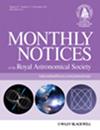McFine:基于 python 的 Monte-Carlo 多成分超正弦结构拟合
IF 4.8
3区 物理与天体物理
Q1 ASTRONOMY & ASTROPHYSICS
引用次数: 0
摘要
星际介质(ISM)中的复杂发射线建模是一个退化的高维问题。在这里,我们介绍一种全自动多分量拟合具有复杂超精细结构的发射线的工具--McFine。我们使用马尔科夫链蒙特卡罗(MCMC)来有效地探索复杂的参数空间,从而确定模型的特征。该工具可用于局部热力学平衡(LTE)和辐射转移(RT)模型。McFine 可以拟合单个光谱和数据立方体,并对立方体鼓励相邻像素之间的空间一致性。它还能拟合最小数量的不同成分,以避免过度拟合。我们对合成光谱进行了测试,在大约 90% 的情况下,它拟合的成分数量是正确的,否则成分数量会稍少一些。通常情况下,Tex 被高估,τ 被低估,但在估计的不确定性范围内是准确的。然而,速度和线宽的恢复精度极高。我们对阿塔卡马大型毫米波/亚毫米波阵列(ALMA)的一个大质量恒星形成区 G316.75-00.00 的 N2H+ 马赛克进行了验证。我们发现,除了在形成 O 型恒星的活跃区域,我们的合成测试具有类似的拟合质量,在这些区域,高斯线剖面或 LTE 假设可能会被打破。为了证明该代码的普遍适用性,我们对附近一个恒星形成星系 NGC 3627 的 CO(J = 2-1)观测结果进行了拟合,同样获得了极好的拟合质量。McFine 提供了一种全自动的方法来分析来自干涉测量观测的丰富数据集,它是开源的,可以用管道安装。本文章由计算机程序翻译,如有差异,请以英文原文为准。
McFine: python-based Monte-Carlo multi-component hyperfine structure fitting
Modelling complex line emission in the interstellar medium (ISM) is a degenerate, high-dimensional problem. Here, we present McFine, a tool for automated multi-component fitting of emission lines with complex hyperfine structure, in a fully automated way. We use Markov chain Monte Carlo (MCMC) to efficiently explore the complex parameter space, allowing for characterising model denegeracies. This tool allows for both local thermodynamic equilibrium (LTE) and radiative-transfer (RT) models. McFine can fit individual spectra and data cubes, and for cubes encourage spatial coherence between neighbouring pixels. It is also built to fit the minimum number of distinct components, to avoid overfitting. We have carried out tests on synthetic spectra, where in around 90 per cent of cases it fits the correct number of components, otherwise slightly fewer components. Typically, Tex is overestimated and τ underestimated, but accurate within the estimated uncertainties. The velocity and line widths are recovered with extremely high accuracy, however. We verify McFine by applying to a large Atacama Large Millimeter/submillimeter Array (ALMA) N2H+ mosaic of an high-mass star forming region, G316.75-00.00. We find a similar quality of fit to our synthetic tests, aside from in the active regions forming O-stars, where the assumptions of Gaussian line profiles or LTE may break down. To show the general applicability of this code, we fit CO(J = 2-1) observations of NGC 3627, a nearby star-forming galaxy, again obtaining excellent fit quality. McFine provides a fully automated way to analyse rich datasets from interferometric observations, is open source, and pip-installable.
求助全文
通过发布文献求助,成功后即可免费获取论文全文。
去求助
来源期刊

Monthly Notices of the Royal Astronomical Society
ASTRONOMY & ASTROPHYSICS-
CiteScore
9.10
自引率
37.50%
发文量
3198
审稿时长
3 months
期刊介绍:
Monthly Notices of the Royal Astronomical Society is one of the world''s leading primary research journals in astronomy and astrophysics, as well as one of the longest established. It publishes the results of original research in positional and dynamical astronomy, astrophysics, radio astronomy, cosmology, space research and the design of astronomical instruments.
 求助内容:
求助内容: 应助结果提醒方式:
应助结果提醒方式:


